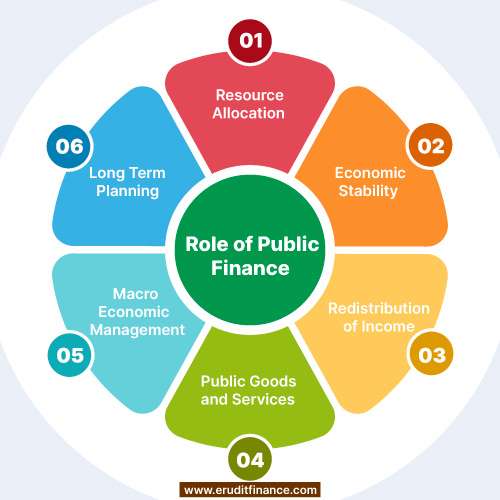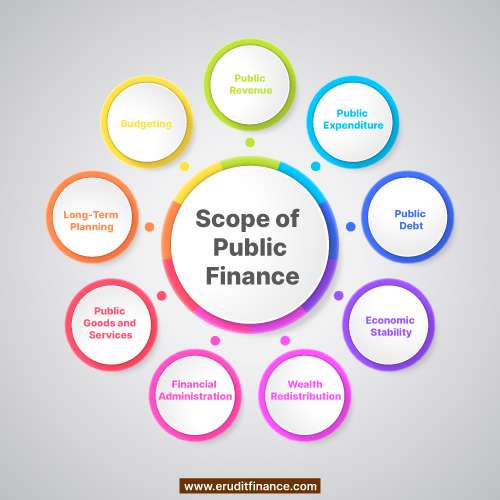Introduction
The scope of Public Finance encompasses the study and management of government revenue, expenditure, and financial policies. It explores how governments generate funds through taxes, manage budgets, allocate resources, and address economic issues for the overall well-being of society. Examining the impact of public finance on economic stability, social programs, and development helps understand its extensive reach in shaping a nation’s financial landscape.
What is the Role of Public Finance?
Public finance entails multiple functions such as mobilizing tax revenues and controlling government spending as well as fiscal policies that contribute to macroeconomic stability and general welfare for society. Key aspects include.

Resource Allocation: For example, public finance makes resource allocation decisions based on what a country should spend its money on, how it should address the nation’s needs, and how it can stimulate growth in the economy.
Economic Stability: Public finance is achieved by using fiscal instruments such as taxes and public expenditure to stabilize the economy, control inflation, and maintain sustainable growth.
Redistribution of Income: A progressive taxation system coupled with a social security program aiming at addressing income inequality aimed at reallocating money to people with lower incomes and those requiring special aid.
Public Goods and Services: This is because public finance enables the delivery of vital public products and provisions, like roads, schools, hospitals, and the army.
Macroeconomic Management: It helps with regulating macroeconomic indicators such as unemployment, inflation, and gross domestic product (GDP).
Long-Term Planning: Strategic public finance involves planning into the future, ensuring fiscal sustainability, and managing inter-generational responsibility.
Public finance is essentially a device that governments use to promote economic and social well-being and national development.
Scope of Public Finance
Public finance comprises a wide range of issues related to fiscal policies adopted by governments. Here’s a detailed overview.
| Public Revenue | Public Expenditure | Public Debt | Budgeting | Economic Stability |
| Wealth Redistribution | Financial Administration | Public Goods & Services | Long-Term Planning | Intergovernmental Relations |

1). Public Revenue- The assessment of ways of raising revenue, comprising taxation, fees, fines, etc. Evaluation of tax policies’ effect on economic behavior and total revenue realization
2). Public Expenditure- Governmental expenditure management to ensure efficient use of resources. Measuring the efficiency of public spending toward accomplishing social objectives and economic growth.
3). Public Debt- Gauging government borrowing and its effects on financial stability. The study of how public debt influences money rates, inflation, and economic stability.
4). Financial Administration- Evaluating the performance and productivity of the financial system and organizational administration from the governmental systems. Providing clarity and promoting responsibility in auditing and reporting.
5). Economic Stability- Fiscal policies for ensuring macroeconomic stability. Tackling such items as inflation, employment, and economic expansion via budgetary policies.
6). Wealth Redistribution- Income inequality is manifested in designing, implementing, and evaluating social welfare programs. Through the use of progressive taxation and means tests.
7). Budgeting- Formulating and implementing government budgets. Ensure financial compliance by monitoring and controlling expenditures. avoidance is a vital part of managing the financial system in all organizations.
8). Public Goods and Services- Provisions for essential social services e.g., education, health care, infrastructure, defense, and others.
9). Intergovernmental Relations- Focal issues include fiscal federalism and financial relations between governments at various levels. Analyzing the allocation of financial burdens between the federal, state, and local governments.
10). Long-Term Planning- Participating in long-term strategic financial planning towards economic sustenance. Intergenerational equity and the consideration of how current fiscal policies affect potential future generations.
The importance of knowing all the aspects of public financing cannot be underestimated as far as effective governance, economic progression, and general welfare are concerned.
What are the Externalities in Public Finance?
Public finance externalities are the unwanted results caused by any public policies and activities upon non-participating parties. Such externality can either be positive or negative but it is mostly outside of the primary stakeholders. Here are examples of externalities in public finance:
Positive Externalities:
Education Programs: Investments in government in education are beneficial to an individual receiving education and improve societal productivity because of a more educated and skillful workforce.
Vaccination Programs: Vaccination programs are aimed at protecting people and benefit the whole community because they prevent the spreading of illnesses.
Negative Externalities:
Environmental Pollution: Healthcare costs could rise while people might experience reduced land values when some government allows industries to emit pollutants in a community that is near them.
Traffic Congestion: Such infrastructure projects or policies promoting individual vehicle modes can contribute more to congestion on the whole and impose social costs on the traffic system.
Externalities must be understood and addressed in public finance to achieve desirable results in society without negatively affecting unwanted beneficiaries. Policymakers most commonly use regulations, taxes, and subsidies, among others, for internalization purposes to achieve socially optimal outcomes.
Bottomline:
As such, the bottom line that describes public finance revolves around its far-reaching scope, which entails examining and directing government revenue, expenditure, and financial policy. This also includes resource allocation, economic stability, the redistribution of income, the provision of public resources, macroeconomic management, and long-term planning. In sum, public finance determines where and how a country’s economy develops, shapes its social life, and optimizes the utilization of resources for sustainable growth.
Comment down your thoughts below!
Related Articles:










